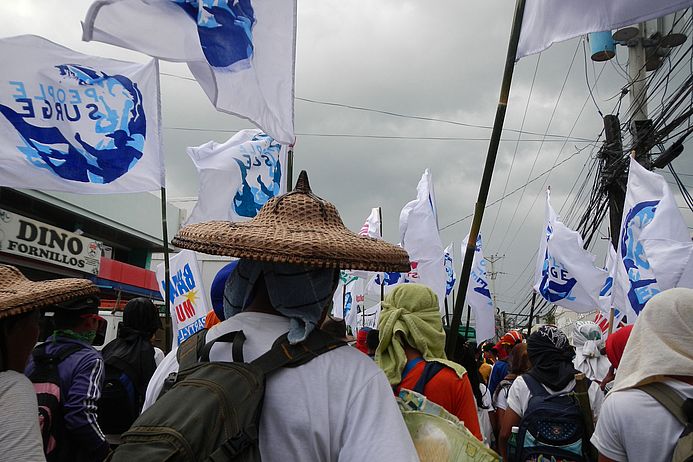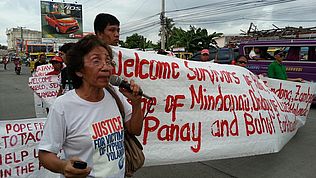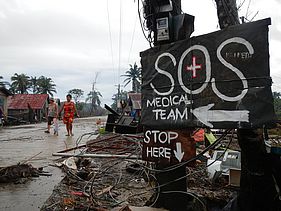A country’s exposure to natural hazards does not alone make it vulnerable to disasters, according to the United Nations. It is when the hazard is combined with poor adaptive capacity, i.e. human vulnerability or sensitivity, the lack of preventive measures and human activities that have harmed the natural environment, that disaster takes place. The Philippines ranks 3rd in disaster risks in the list of 173 countries, next only to small countries such as Vanuatu and Tonga. The Philippines’ high disaster vulnerability is clearly a function of chronic poverty and economic underdevelopment as well as policies that cater to elite and foreign plunder of natural resources and reduce government responsibilities.
Study: Disaster Upon Disater - Lessons Beyond Yolanda
Typhoon Yolanda brought to fore the country’s poor adaptive capacity. This was manifested clearly by the Aquino government’s lack of preparations to reduce the risks and by its post-calamity negligence as well as opportunism. The disaster brought out deep-seated faults in economics and governance as well as highlighted the role of systemic corruption, patronage politics and dependence on foreign powers in reducing the country’s overall adaptive capacity.
It is not as though the Philippine government is not aware of the country’s exposure to natural hazards and extreme climate conditions. The Philippine archipelago is composed of 7,100 islands, mostly low-lying areas, making it susceptible to sea level rise. It has the longest coastline in the world, making it susceptible to storm surges. Its mountainous topography and steep slopes, on the other hand, sits on a complex fault system that runs all throughout the archipelago, making it prone to landslides and mudslides.
The country is greatly influenced by monsoons, which bring significant rainfall in the case of the Southwest monsoon or cooler and drier weather in the case of the Northeast monsoon. It is also prone to the El Niño-Southern Oscillation (ENSO), the irregular cycle of warming and cooling of the sea surface temperatures of the Pacific Ocean along Ecuador, Peru and Chile, which contributes to periodic drought and extreme sea levels and subsequent flooding across the southwest Pacific, including the Philippine archipelago. Lastly, around 19 typhoons enter the Philippine area of responsibility in a typical year, usually 6 to 9 of which make landfall. These typhoons are usually associated with high winds, storm surges and extreme rainfall.
These challenges are permanent features of the Philippines and its geographic region. They are not new to the Philippines, and the Aquino government is also not unaware how anthropogenic climate change has significantly altered these climate challenges to result in climate extremes and surprises. The country has experienced the worst catastrophes due to the increasing frequency of super-typhoons in the last four decades, which scientists are tracing to climate change.
Yet, the Aquino government failed to think and apply hard lessons. It failed to strengthen the country’s adaptive capacity, unfortunately because its mindset has been solely focused on private business and in running the government like a business. The Aquino government has faltered in all phases of response – from disaster preparedness, search and rescue, relief, rehabilitation, to reconstruction, including accounting of relief goods and funds, because of its privatization policy and reliance on the private sector.
The presence of the national government was not felt in the most critical hours after Typhoon Yolanda hit. Immediately it relied on the private sector to do search and rescue, still it could not mobilize its own transportation and communication facilities to deliver relief, since these had already been privatized. The deficiency of the government’s infrastructure-centered PPP projects came to fore as the Aquino government sorely lacked food and water relief mechanisms as well as sturdy evacuation centers. It was even incapable of burying the dead.
Relief was as scarce as original resources were, and relief operations stopped even if survivors were still scrambling to find food. Ironically still, the Aquino government sent military troops to stop the survivors from ‘looting’.
What was further revealed was that at the height of crisis situations, the government’s response would be stuck in or continue to be dictated by corruption and patronage politics. Corruption and politicking in disaster response, including release of discretionary funds to serve political ends or the non-release of relief goods and funds, sadly characterized what transpired even a year after Typhoon Yolanda. National and local officials engaged in blame game in the middle of relief operations, while the much-needed relief packs were rotting in government warehouses or were being sold in commercial establishments. Official relief goods were reportedly not reaching disaster areas, not only because government response was focused on Tacloban City but also due to patronage politics where provinces of the administration’s allies were being prioritized.
The Aquino administration also sought to tax donations that were not going through the government, especially after it became obvious that much of the aid coming in was being coursed through humanitarian organizations, civic groups and private institutions instead of the government.
Typhoon Yolanda set a record on disaster response as being the most militarized. The US has increasingly used a militarized disaster response to justify prolonged US military intervention, like what it did in Haiti during the earthquake in 2010. The Aquino government, on the other hand, had used the scenario where the US was airlifting survivors and flying in and out of the areas as justification for the framework agreement with the US for increased rotational presence.
The role of the media in disaster coverage also showed conflicting interests in reportage, whether as a media outfit with social responsibilities, a charity and humanitarian organization, or as a corporation with vested interests. What became obvious with Typhoon Yolanda was that in addition to the confused roles of media, the media also acted as government’s propaganda machinery that seemingly downplayed official negligence and accountability.
In the end, irony of ironies, Yolanda-affected areas have suddenly become an investors’ dream. In a more-business-than-usual approach, the Philippine government has adopted a framework that purportedly rebuilds disaster-stricken countries but in the way that prioritizes corporate interests. Coastal areas are to be developed for other commercial interests such as highend tourism rather than fisheries, mining and property development rather than agriculture. With a ‘no-build zone’ policy that has been proven to have disregarded the plight of survivors in Haiti, Sri Lanka, Indonesia, India, Thailand, Maldives, Pakistan, Central American countries and even in New Orleans in the US, the Philippine government has chosen to uphold corporate interests in reconstruction and recovery.
‘Build back better’ does not address existing social and human sensitivity as root causes of vulnerability, in the case of Eastern Visayas, the prevailing backward conditions of its agrarian economy prior to Yolanda.
The region is mired in feudal structures of ownership and production that have chronically impoverished its population. The government’s policies of resource plunder, such as liberalized mining, have only served to exacerbate the erosion of the natural economy on which the majority of the people depend for life and livelihood.
It is not the focus of rehabilitation efforts to solve these basic problems that have been there beforehand and have weakened the country’s adaptive capacity. On the contrary, there are indications that the rehabilitation plan is even bound to exacerbate the country’s lack of adaptive capacity including a resilient economy.
Survivors have taken on the advocacy to demand the provision of basic needs even after more than a year, make the Aquino government accountable for the vast damage, to expose and oppose the corporateled rehabilitation plan, and push for policies that put an end to natural resources plunder and exploitative production structures. If there were one bright spot in the middle of this devastating social storm, it would be how the Yolanda survivors have organized themselves to rebuild and increase their capacities for disaster preparedness, disaster risk reduction, people-centered responses, and community development. One crucial element in this organization is the recognition that only by striking at the roots of disaster vulnerability shall efforts towards disaster management become truly meaningful. Under the current circumstances, however, without a doubt this will have to be spearheaded by the people’s movement.



